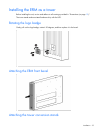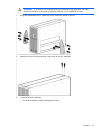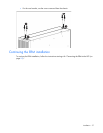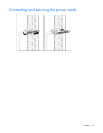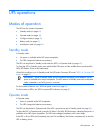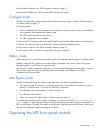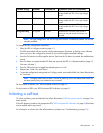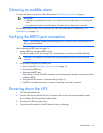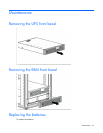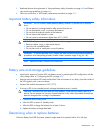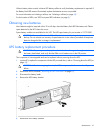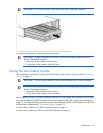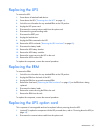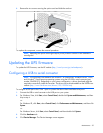
UPS operations 43
Available settings Parameter Associated LED Explanation (when LED is illuminated)
110/220 Nom Battery Fault Nominal output voltage is 110 V for a low
voltage model and 220 V for a high voltage
model
120/230 Nom Site Wiring Fault Nominal output voltage is 120 V for a low
voltage model and 230 V for a high voltage
model
127/240 Nom Overtemperature Nominal output voltage is 127 V for a low
voltage model and 240 V for a high voltage
model
Wiring fault setting
Wiring fault Overload Audible alarm will sound when ground is
missing or line and neutral connections are
reversed
NOTE: For high voltage UPSs, the Site Wiring Fault function is disabled by default, but can be
manually enabled.
To change the UPS configuration parameters:
1. Place the UPS in Configure mode (on page 41).
The LEDs associated with the currently configured parameters illuminate. A flashing cursor indicates
where you are in the configuration process as you scroll through the available settings.
2. Press the On button to scroll through the options. Each time the On button is pressed, the audible alarm
sounds.
3. If the On button is pressed and the UPS does not respond, the UPS is in Operate mode (on page 40).
Start over with step 1.
4. Press the Off button once to toggle the selected option on or off.
5. Repeat steps 2 and 3 for each option.
6. To save the configuration settings and exit Configure mode, press and hold the Test/Alarm Reset button
for 3 seconds.
NOTE: Configure mode times out after 2 minutes of inactivity. If the Test/Alarm Reset button has
not been pressed, any new selections are not saved.
For the location of buttons, see "UPS front panel controls (on page 8)."
For the location of LEDs, see "UPS front panel LED indicators (on page 8)."
Initiating a self-test
To initiate a self-test, press and hold the Test/Alarm Reset button ("UPS front panel controls" on page 8) for
three seconds.
If the UPS detects a problem, the appropriate LED ("UPS front panel LED indicators" on page 8) illuminates
and an audible alarm may sound.
For information on what to do if the self-test detects a problem, see "Troubleshooting (on page 55)."



